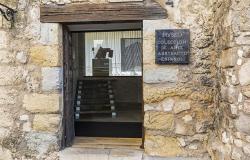The Protestant reverend Dorus van Gogh and his wife, Anna Carbentus, had seven children. The firstborn, named Vincent, was stillborn on March 30, 1852. Just a year later he came into the world Vincent Willem van Gogh, baptized on April 24, 1853, died of a pistol shot in 1890 (there are different theories about this event and the most widely assumed is that of suicide) and considered one of the most important and turbulent figures in the history of painting.
The marriage produced, until 1867, two more sons (Theo and Cor) and three daughters (Anna, Lies and Wil). These three women are the protagonists of the book The Van Gogh Sisters that Cátedra has just published in Spain. The author is the art historian Willem-Jan Verlinden, who learned of its existence when, years ago, he was working on a study of the painter’s London years.
He was fascinated by the “hazardous lives” of Anna, Lies (Elisabeth) and Wil (Willemien). And he began an investigation based on the letters written by them and reinforced by other documents (some from private archives) such as educational records, medical reports, photographs, certificates and Vincent’s drawings and paintings.
A story that begins with the unexpected death, in 1885, of Dorus van Gogh, which has a destabilizing effect on the family. Shortly after the funeral a big fight breaks out between the eccentric and occasionally aggressive Vincent, who did not get along with his father, and his sister Anna. The artist leaves the family home, in Neuen, and the Netherlands forever.
The little sister, Wil, remains by her mother’s side, with whom she moves to Breda and then to Leiden, where Anna lived with her husband and daughters. Wil was an independent woman who never married or had children. She dedicated herself, as a nurse, to the care of the poor and the elderly and was a protagonist in the first wave of Dutch feminism. She also suffered mental problems that became worse. Vincent and Wil were the unorthodox ones in the family.
A protected childhood
The six brothers, according to Verlinden, had in Zundert, a small rural town in North Brabant where their father had found a permanent job, a “protected and worry-free” childhood, with a patriotic and highly moral education.
The family was part of the Protestant minority in a predominantly Catholic area.. In her memoir, Lies recalls the reclusive personality of her brother Vincent, her first drawings, her love of nature, and her hobby of collecting beetles.
Among the experiences included in the book is Anna’s transfer at the age of 17 to the French Boarding School for Young Ladies in Leuvardenwhere Lies also passed, who began to worry about the social changes that were taking place in the Netherlands.
Upon leaving boarding school, Anna decides to look for work as a governess in England, where she travels with Vincent.. She finds a position as an assistant teacher at a small school in Welwyn. She earns little money, but she was happy at this stage. Wil, still a teenager, visited her and spent nine months with her. Meanwhile, Vincent leaves London to work at the Goupil branch in Paris.
[Amistad, pobreza y locura: así pintó Van Gogh ‘Los girasoles’]
Shortly after returning from England, Anna meets Joan van Houten, director of a lime factory, whom she marries. The entire family expresses their happiness at the wedding, except for the skeptical Vincent.who expresses his doubts to his brother Theo in one of the many letters he wrote to him.
He has decided to become a pastor and moves to Amsterdam to study Greek and Latin. It won’t be long before, in a new twist, he considers dedicating himself to painting. The worries that Vincent causes to his parents are alleviated by the birth of his first granddaughter, Sara Maria van Houten, daughter of Anna. We are in 1880.
Two years later, the Van Goghs moved to Neuen, where Dorus continued his challenge to strengthen the Protestant community of North Brabant. It is a complicated moment for the country due to the agrarian crisis. Wil begins to have contact with people outside the family circle and establishes a friendship with Margaretha Meijboom, daughter of an Amsterdam pastor who taught Sunday school.
In the letters they send, issues such as family, health, literature and music emerge. Take care of her parents and also of Lies. The death of Dorus and Anna’s fight with Vincent leave the sisters very affected. A few months later, a decisive woman for the Van Goghs enters the scene, Johanna Gesina Bonger, known as Jo, who would become Theo’s wife and preserver of Vincent’s legacy.
Jo and Lies begin a long correspondence. They talk about their appearance, their vanities, about work and money and housework. They share intimate experiences and aesthetic comments. Jo likes George Eliot, Shelley and Goethe (but not French writers); to Lies, Dickens. The Van Goghs were very fond of reading and writing letters: sometimes they wrote several a day.
Lies also becomes a mother, with the husband of a woman she had been caring for, Jean Philippe du Quesne. While traveling with him, his daughter Hubertina was born in a hotel. Wil is in Breda with his mother and starts working as a florist. But she is not happy, she feels alone and travels whenever she can (The Hague, Paris, Brussels…). She ended up settling with Anna in Leiden in 1887.
His second trip to Paris is exciting for Wil. The French capital is experiencing a vibrant period. Vincent writes to him from the asylum of Saint-Rémy-de-Provence in January 1890. He has only a few months to live. Theo and Jo add a new member to the family, named Vincent Willem in honor of his godfather. Pregnancy and childbirth leave Jo exhausted, and Wil helps her convalesce.
“I really hope to paint your portrait”
While he could, Wil developed his vocation for caring. He also helped her sister Lies with Mrs. Du Quesne. He shares his drawings with Margaretha, and with Vincent his concern about the mental health problems they both suffered from. The painter shows more interest in her than in Anna and Lies. A month before he died, he wrote to her: “I very much hope to paint your portrait one day.” She never fulfilled that wish.
Wil is excited about the new professional perspectives that open up to her as a nurse when she receives the news of her brother’s death. For Verlinden, “there is not much doubt” that it was a case of autolysis. The Van Goghs wrote numerous letters to each other in which they expressed and shared their pain. “It certainly won’t be forgotten,” Theo tells Lies.
Vincent’s death brings Lies and Anna back to her mother’s house in Leiden. Cor has emigrated to South Africa. On January 25 of the following year, Theo, who had contracted syphilis, died. 1891 is a year of mourning for the mother and sisters, although in December they celebrate Lies’ wedding with his lover, Mrs. Du Quesne, who had already died.
On the other hand, the family begins to receive news about the growing interest in Vincent’s work both in the Netherlands and abroad. Jo moves to Bussum and dedicates herself to promoting her brother-in-law’s legacyefforts that would crystallize in exhibitions in The Hague and Amsterdam in 1892.
[La eternidad según Van Gogh y Schnabel]
In The Hague, Wil joins the Dameslees Museum, a library and meeting place for wealthy women. She gets involved in social struggles and women’s associations alongside other progressive-minded women. She participated in the organization of the National Exhibition of Women’s Work, in 1898. But his mental health was about to experience a serious deterioration.
Hard times
What terrible times! is the title of the fifteenth chapter of lThe Van Gogh Sisters, which covers the period 1900-1920. Start with the death, in the Second Boer War, of the younger brother, Cor, that he had had a short marriage to a German woman who abandoned him and stole most of his possessions.
Wil was referred to the Veldwijk psychiatric hospital in Ermelo, where she would spend almost half of her life. Her mother died in 1907. At that point, Vincent’s success, to which Jo has contributed so much, is reaching an enormous dimension. Letters between Lies, Anna and Jo reveal their dismay at Wil’s deterioration, who hardly left his room. Financial difficulties plague Lies, whose husband also appears to have some mental problems. She will die on Christmas Day 1921.
Lies published several books (especially poetry)among them, in 1910, Vincent van Gogh: personal memoirs about an artist, a commercial success translated into several languages but which caused a confrontation with Jo, who was preparing the edition of the painter’s letters accompanied by a brief biography. Lies had not shown much interest in her brother Vincent, but Verlinden notes that “that began to change” with the increase in the artist’s international fame.
In his final years, Lies’s financial situation became desperate. She died in 1936, six years after Anna, five before Wil, and she was buried in the Veldwijk cemetery, in the vicinity of the psychiatric hospital, where her tombstone can be seen. In 1941 the last member of the Van Gogh-Carbentus family thus disappeared.
The work of Jo, who died in 1925, was continued by her son, who also inherited Wil’s collection. Vincent’s fame continued to grow throughout the 20th century to unthinkable heights.
This is, in summary, the story of Anna, Lies and Wil: “the pious one”, “the eccentric poet” and “Vincent’s favorite”. The Van Gogh Sisters.






